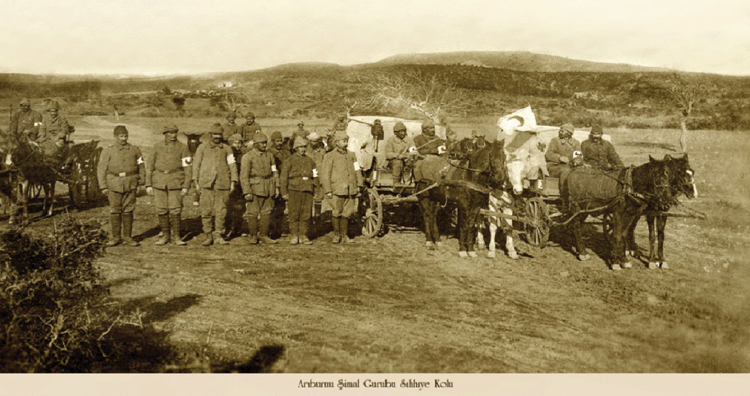The fight against typhus in the Ottoman Army during World War I
Ahmet C Başustaoğlu A and Sadık Emre Karakuş BA Eastern Mediterranean University
Faculty of Pharmacy
Department of Microbiology Famagusta
Turkish Republic of Northern Cyprus
Email: basustaoglu@gmail.com
B Turkish Ministry of Defence
Archive Command
Ankara, Turkey
Email: sadik.karakus@msb.gov.tr
Microbiology Australia 35(3) 148-152 https://doi.org/10.1071/MA14055
Published: 5 September 2014
Five major outbreaks were encountered in the armed forces: (1) typhoid fever; (2) typhus (Rickettsia spp.); (3) Borrelia reccurentis-induced relapsing fever; (4) dysentery; and (5) cholera. Infectious diseases had a devastating effect on Turkish soldiers and in particular typhus was one of the most recognised and widespread diseases throughout Ottoman Empire.
As outlined in our previous article during WWI, Ottomans were fighting not only against the allies but also severe weather conditions and infectious diseases and as a result deaths from such causes exceeded the number of deaths at combat. During the war, 62% of the deaths were due to diseases, including 43% from infectious diseases, as well as a lack of expert medical teams and effective drugs. Health Minister of the 3rd Army Prof. Dr Tevfik Salim (in the Republican era Tevfik Sağlam, hereafter in the text Tevfik Salim (Sağlam) explained these tragic losses in terms of four main reasons: (1) seasonal extremes; (2) transport and travel difficulties; (3) lack of proper clothing; and (4) malnutrition. Even a much useful remedy such as Neosalvarsan, which was effective against the Borrelia reccurentis-induced relapsing fever, had become unavailable. It was difficult to dispatch vaccines since transport from İstanbul stopped at a certain point and in order to reach the combat field, motorcars (if possible) or horses and mules were needed (Figure 1). Medical personnel did not have any medication or vaccines but only had the practical knowledge gained from their seniors at the Gülhane Military Medical Academy as well as through their experiences during the Balkan War. They were fully aware of the urgency to ensure public health first and also the need to increase awareness and information regarding the diseases among the institutional staff. However, the area to be covered was vast and the means of communication were limited. The fight against the five diseases by under-resourced Turkish medical personnel, in particular eradication efforts against the causative agent carrying vectors were recognised internationally and has a place in the world military history1–13.
First ever success against Rickettsia and Borrelia infections was achieved after then Lieutenant Colonel Dr Tevfik Salim (Sağlam)’s appointment to the 3rd Army in March 1915 (Figure 2). Because of typhus senior commanders of the 3rd Army were dying in hospitals and the Ottoman Army Health Commander Süleyman Pasha was also at the hospital. Dr Tevfik Salim (Sağlam)’s most significant observation was the shared room experience of patients infected with different diseases. It was known that both Rickettsia and Borrelia infections were introduced by the vectors that had to be eradicated. However, there was material shortage and also inadequate hospital wards, bedding, bandages and disinfectants as well as vaccines.
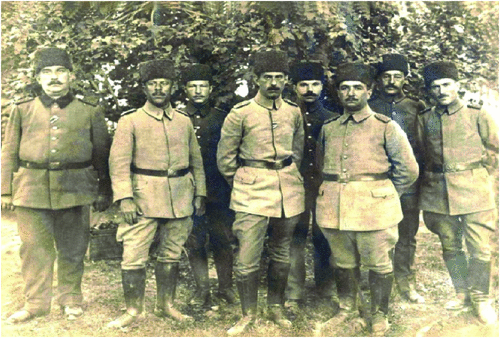
|
Soldiers reached the war region on foot and came into close contact with peasants on the way. Both the soldiers and village folk were infested with lice, as the soldiers found no washing facilities on the way to the warfront or when they arrived at their posts. Both cities and villages were in chaotic conditions where soldiers and the members of public shared the same shelters. In the early years of war, conditions were conducive to vector disseminated diseases, and the Turkish doctors were fully aware that these circumstances led to lice-disseminated diseases but lacked the infrastructure to rectify the situation. Disinfection equipment was almost non-existent and at the beginning of the WWI, in the 3rd Army possessed only two fixed (located in Erzurum and Trabzon) and two mobile autoclaves. There was no real disinfection gear, and no sterilisation ovens and steam chambers. It was not clear whether mobile autoclaves could be transported in winter times and if they would be functional at their place of arrival. Typhus rapidly became an epidemic under these optimal conditions. The war had started with bloody battles that lasted for 3 weeks followed by a month of slowdown. In 1914 from October to December 138 out of 357 typhus patients died as well as 72 out of 167 relapsing fever patients. The real tragedy came after the defeat of Sarıkamış where the majority of soldiers perished due to freezing conditions. The retreat of survivors in misery towards the villages of Erzurum, Hasankale and Pasinler, created a huge influx that filled the hospitals beyond capacity and infected the doctors and medical personnel working in those hospitals. Commander İsmail Hakkı Pasha died of the disease and Medical inspector Süleyman Numan was also infected with the disease. Although reliable statistical input was unavailable then, data from January 1915 indicate 522 typhus patients with 251 deaths and 223 Borrelia reccurentis infected patients with 121 deaths. In Erzurum, 20–30 civilians were dying of the disease every day. In March, after a heavy impact, the disease lost its severity at the war front; however, it continued to impact those at the back, such as the gendarmerie, as well as civilians.
Differentiating diagnosis of Borrelia reccurentis infections was carried out by means of blood analysis where characteristic spirals were detected; some patients were even infected with both. The drug neosalvarsan was effective against relapsing fever; however, fight against typhus could only be achieved through the eradication of the vector lice. A patient without lice infestation did not constitute a danger to others. The most neglected sources of infection were transport centres, prisons, headquarters, and points of distribution. These were found in populated towns and were open to lice infestations and subsequent infections. Under poor sanitary conditions infested soldiers were shedding their lice, which in turn infested other soldiers.
Turkish 3rd Army was in desperate need for disinfection equipment that could be used and repaired with ease (Figure 3). Dr Abdülkadir Lütfi (in the Republican era Emeritus Prof. Dr Abdülkadir Noyan) even used bread ovens in which disinfection was possible due to dry air circulation. These ovens were easy to construct at every front. Due to lack of thermometers to measure the temperature the degree of heat was identified using a white sheet of paper. Optimum heat for lice disinfection changed the paper to a yellowish colour without it being burnt. Fire was then removed, a wet sac placed on the oven base, sprayed with water and lice infested clothing would go in. After the closure of the oven lid the first exposure would last for 10–15 min, second batch would stay for 20–25 min and the third would be kept in the oven for half an hour.
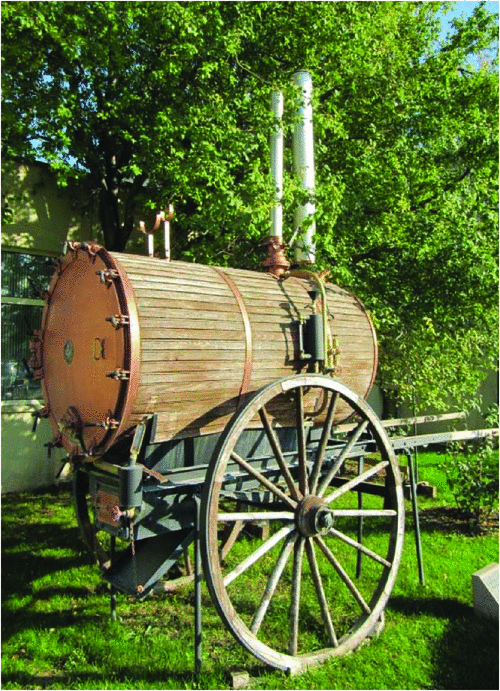
|
After the initial heat generation in the oven, three batches of clothing would be disinfected. The practice was recommended to troops under the title of ‘Hot air circulation and disinfection oven’. The only risk was the complete burning of the items. Dr Tevfik Salim (Sağlam), to prevent this, recommended that 4 to 5 litres of water be placed in the oven to ensure mist, although it did not completely eliminate the risk of burning. Villagers also used ground ovens for disinfection purposes although the oven size was too limited to cater for large number of clothing items.
From the spring of 1915 onwards, oven disinfection method was widely used with successful outcomes. The real innovation was introduced in 1916 by Chief Medical Officer at the Sivas front, Dr Ahmet Fikri Bey (in the Republican era Dr Ahmet Tüzer), who designed a steam chamber and recommended its use in the army (Figure 4).
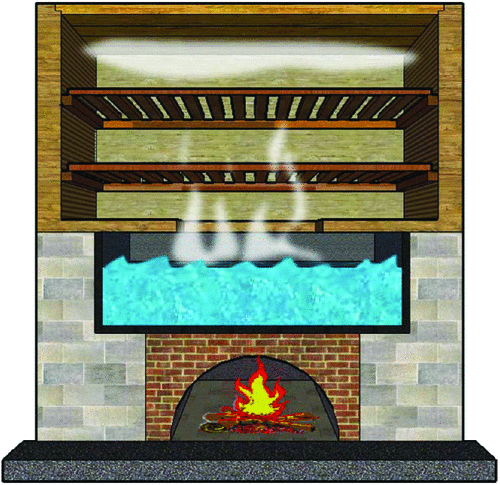
|
The steam chamber consisted of a boiling pot and a cased box. An ordinary kitchen receptacle was encased in a cook-top with a flat surface. The cased box was made of timber 2 metres high and one metre wide. A hole was made underneath the cased box smaller than the pot and covered with felt in order not to allow the steam out of the lid. The box was then sealed on the cooker with mud and hooks.
In the chamber, steaming water made it possible to eliminate lice and ensure disinfection. It was a real breakthrough and easily applicable anywhere. Anyone with basic carpentry skills could build a steam chamber and repair if broke down, the cost of construction was low and there was no risk of burning the clothes placed inside. After preliminary testing and successful outcomes, the steam chamber became widespread and used in the army, health centres and homes to fight infectious diseases and only after the steam chamber lice were completely eradicated from the barracks. The role of the centres for disinfection based on the steam chamber use can be appreciated if figures from a period of 13 months in 1917–1918 are taken into account. A total of 2,225,262 clothing items and 2,283,095 individuals were disinfected in these centres.
Vaccination practice
Dr Tevfik Salim (Sağlam) and his colleagues were aware that the officers who gained immunity against typhus were those who had survived the disease in Yemen. During WWI, medical doctors came to the conclusion that the disease they had failed to diagnose previously when encountered in Yemen was also typhus. Vaccine was thus administered against typhus in the 3rd Army. Before his departure for the 3rd Army in 1915, Dr Reşat Rıza (in the Republican era Dr Reşat Kor) discussed the measures against typhus with Dr Tevfik Salim (Sağlam), and he proposed the administration of a vaccine as designed by himself. The weakened infective agent would be administered on the body to provoke a reaction from the immune system. The infective agent of typhus was still unknown but they made the assumption that it was present in the blood, therefore blood samples from a typhus patient could be used to prepare the vaccine rather than a cultured sample. The typhus agent lost its strength if kept at 55°C for 15 minutes, so the blood sample could be inactivated at 58−60°C. Sterile blood samples of 10–20 mL taken from a typhus patient at the peak moment of the disease were placed in a glass bottle containing glass beads and shaken well for fibrin removal. Next, the bottle, completely immersed in water, was heated in a bain-marie at 55−58°C and rotated frequently. After it was taken out, the neck of the bottle would be flame-sterilised and the blood sample poured into a container to be administered subcutaneously (1–2 mL) using a syringe.
The typhus vaccination of this type had two major flaws. Firstly, the amount of blood was empirically limited to 1–2 mL without any specification of the infective agents contained. The results varied due to the disease’s strength, its actual phase and many other factors yet unknown to those who administered the vaccine. Secondly, the blood samples could not be collected in large batches from typhus infected patients, and only 2–4 people could be vaccinated at a time once a sample was taken. Due to such limitations, the vaccine was administered only in the case of high-risk personnel in hospitals.
The first ever typhus vaccine worldwide was prepared on 28 March 1915 at Hasankale by Dr Tevfik Salim (Sağlam) himself and the first ever volunteers to be vaccinated were Dr İhsan Arif, Dr Tevfik İsmail, Dr Haydar Cemal, Dr Salahaddin, Dr Süreyya Ali, Major Zihni, Lieutenant İsmail Hakkı, Cemil Bey and Namık Bey, a total of nine army officers with five of these working as medical doctors at Hasankale hospital among typhus-infected and lice-infested patients. Dr Salahaddin fell ill the day he was vaccinated, Dr Haydar Cemal three days after the vaccination, Dr İhsan Arif five days after the vaccination and Dr Tevfik İsmail seven days after the vaccination. The remaining five officers were unaffected. Dr Salahaddin and Dr Haydar Cemal suffered a very heavy form of the disease for two weeks whereas Dr İhsan Arif and Dr Tevfik İsmail were light cases. The appearance of these cases led to scrutiny over the vaccine’s success, but it was concluded that as the medical staff worked among typhus patients with lice, they had been infected previously, and received the vaccine at the moment of incubation. Those late cases of infection suffered a weaker form of the disease, which was welcomed as a successful outcome brought about by the vaccine. The same method was applied to a greater number of people by his colleagues later on (see below). The administrations in the 3rd Army and during the Turkish War of Independence also proved that the vaccine posed no risk.
In Erzurum, Dr Alaattin administered the vaccine on 263 persons between 23 April and 7 June 1915 with only three catching the disease. The demographic breakdown of these 263 vaccination cases is as follows: 234 Muslims, 26 Armenians, 3 Greeks with a total of 47 army officers, 9 medical doctors, 174 hospital workers, 6 civil servants, 27 soldiers on special duty. Bacteriologist Dr Abdülhalim Asım also vaccinated 130 individuals in Bayburt. Vaccination practice in Sivas was undertaken by Lieutenant İzak, a medical doctor and out of 156 hospital workers he vaccinated five caught typhus and one died. Out of a group of 35 hospital workers who also worked under similar conditions and received no vaccination, two caught the disease and one died. Dr Tevfik İsmail administered the vaccine on 110 soldiers in Erzurum, and Erzurum Red Crescent Hospital staff also administered the vaccine on 166 individuals between 28 April and 19 June 1915, who were tracked until 25 October. Only one person caught the disease and survived, and around Hasankale, some 44 persons were vaccinated by Dr Mihran. As the vaccine administration continued, many high rank army officers, army and medical personnel, and civil servants volunteered to be vaccinated and priority was given to health workers and those professionals in high demand at the time of war. Vaccine applications were not limited to the 3rd Army. Dr Abdülkadir (in the Republican era Dr Abdülkadir Noyan) extended the administrations to the 6th Army in Baghdad, and vaccinated the Army Chief Kazım Karabekir together with 76 officers, 20 doctors and 20 nurses. The Commander of the 6th Army General von der Goltz Pasha and his private doctor Oberndorfer who rejected the vaccination due to mistrust, later died of the disease, when all other vaccinated patients survived. Figures 5 and 6 below show a drop in infected cases by 42% in 1916, by 75% in 1917, by 94% in 1918 compared to the high number of infected cases and deaths in 1915. The improvement of hygiene and hospital services across that period played the biggest part in this drop.
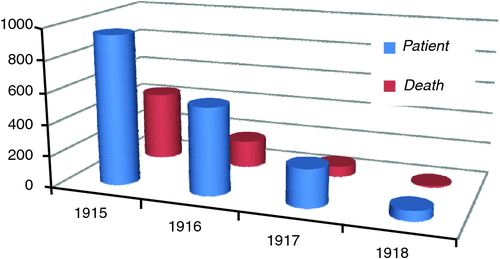
|
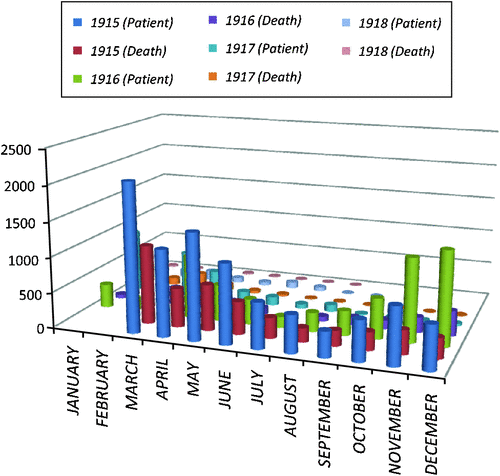
|
As can be seen from the figures above, typhus reached its peak during the winter months of 1914–1915, slowed down in the summer of 1915 with an increase again in October. The reduced numbers of cases from January to March were due to military movements in those months. After a peak in April, it reached its lowest in July and steadily increased month by month after that with a peak again in December and a slowdown followed. From the winter of 1917–1918 onwards, its peaks were not as high and typhus almost disappeared after August–September 1918.
The severity of typhus might have been related to the factors listed below:
-
Seasonal impact (cold months were more conducive to disease)
-
Infection rate went down during troop movements but gained severity again afterwards
-
With effective disinfection processes its impact was reduced
-
With effective treatments seasonal impact was eliminated (e.g. 1917–1918 winter).
In 1918 out of the 101 infected patients were members of the 123rd Regiment who carried it from İstanbul. As illustrated in the figures above, from March 1915 to September 1918, 19,619 members of the 3rd Army had typhus and 7,310 died of it. Typhus patients were 3.4% of all the patients (564,498) and 6.6% of the total deaths (105,761) occurred at the time.
References
[1] Noyan, A. (1956) Son Harplerde Salgın hastalıklarla savaşlarım. Son Havadis Matbaası, Ankara.[2] Başustaoğlu, A.C. et al. (2012) Balkan, Birinci Dünya ve Kurtuluş Savaşlarında Türk Ordusunun Mikrobiyolojik Etkenlere Bağlı Kayıpları. Conference presentation (35th Congress of the Turkish Society for Microbiology, 3–7 November), Kuşadası, Turkey.
[3] Sönmez, B. and Yıldız, R. (2010) Ateşe Dönen Dünya: Sarıkamış. İkarus Yayınları, İstanbul.
[4] Eti, G. (2009) Bir Onbaşının Doğu Cephesi Günlüğü, 1914–1915, Ali Rıza Eti. Türkiye İş Bankası Kültür Yayınları.
[5] Becker, H. (1983) 1. Dünya Savaşında (1914–1918) Osmanlı Cephesinde Askeri Tababet ve Eczacılık, (Translation), İstanbul.
[6] Özdemir, H. (2005) Salgın Hastalıklardan Ölümler. Türk Tarih Kurumu Yayınları, Ankara.
[7] Özbay, K. (1976) Türk Asker Hekimliği Tarihi ve Asker Hastaneleri(Cilt-1, 2, 3). Yörük Basımevi, İstanbul.
[8] Karatepe, M. (1999) PhD Thesis: 1.Dünya Savaşında Kafkas Cephesinde Tifüsle Mücadele. İstanbul Üniversitesi, Sağlık Bilimleri Enstitüsü, Deontoloji ve Tıp tarihi Anabilim Dalı, İstanbul.
[9] Dağlar, O. (2010) Macar, Balkan Savaşlarında Salgın Hastalıklar ve Sağlık Hizmetleri. Libra Yayıncılık, İstanbul.
[10] Alpaslan, T. (2008) Sarıkamış, Bir Destandır, Bu Destanın Bilinmeyen Öyküsü. Kumsaati Yayınları.
[11] Sağlam, T. (1968) 3. Orduda Tifüs Aşısı Meselesi. In: Tevfik İsmail Gökçe, Neşati Üster, Tevfik Sağlam (Eds.) (1882–1963) İkinci Cilt, İsmail Akgün Matbaası, 287-292, İstanbul.
[12] Sağlam, T. (1941) Büyük Harpte 3. Orduda Sıhhi Hizmet. Askeri Matbaa.
[13] Sağlam, T. (1939) Cihan Harbinde 3.Orduda Sıhhi Hizmete Ait Küçük Bir Hülasa. Gülhane Müsameresinde verilen konferans.


